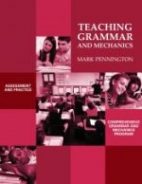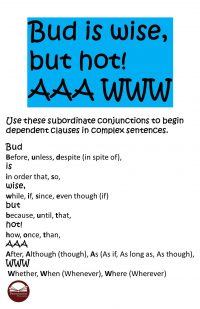The Ten Parts of Speech with Clear Examples
Imagine trying to use the common tools in a toolbox without knowing their respective names or functions. A master carpenter would certainly do a disservice to an apprentice by avoiding such instruction.
“Take out that silver thing; no, not that one… the other one. Figure out on your own how to use it to cut these moldings.” How inefficient. How silly. How dangerous.
True, we could probably design research studies which show no statistically significant differences in terms of the quality of a finished good produced by some trained and untrained apprentices; however, most of us would acknowledge that the process does matter in producing such a good. An ignorant apprentice who uses the wrong tools, takes too much time, or cuts herself yet achieves the same quality of finished moldings is certainly not as preferable as the trained apprentice who uses each tool correctly, works efficiently, and bleeds less. Which one would you hire to do your moldings at your house?
Similarly, we English-language arts teachers need to equip our students with the tools of effective speaking and writing. One important set of tools is the parts of speech. And yes, we need to teach the names and functions of each tool.
Knowing the parts of speech helps students not only “talk the talk,” but also “walk the walk” in terms of coherent and effective speaking and writing. Scaling the language barrier is important for students (and teachers) so that matters of grammar, usage, sentence structure, sentence variety, mood, tone, and emphasis can be discussed intelligently.
“Take a subject case pronoun out of your toolbox to substitute for the repetitive use of that proper noun.” How efficient. How transferable. How effective.
Now, it should go without saying, but an apprentice carpenter would not learn her trade by memorizing the name and function of the tools in isolation. She would also need to put her knowledge into practice under the guidance and modeling of the master carpenter. Yes, there would be mistakes: error analysis is important. However, also seeing things done correctly with guided practice will produce the intended results.
1. A common noun is a person, place, idea, or thing. It is capitalized only at the start of a sentence. It can be a single word, a group of words, or a hyphenated word.
Examples:
The girl was learning to drive
-person (girl)
next to the ocean;
-place (ocean)
It takes self-control
-idea (self-control)
to earn a driver’s license.
-thing (license)
2. A proper noun is the name of a person, place, or thing. It is always capitalized. It may be a single word, a group of words (with or without abbreviations), or a hyphenated word.
Examples:
Josh was honored
-person (Josh)
at U.S. Memorial Auditorium
-place (U.S. Memorial Auditorium)
with the Smith-Lee Award.
-thing (Smith-Lee Award)
3. A pronoun is a word used in place of a noun(s). It can be in the subject case, acting as a “do-er” of the action in the subject case, or acting as a “receiver” of the action in the object case. Pronouns can also serve as singular or plural possessives to show ownership.
Examples:
She walked to town.
-subject case (She)
I gave her a basket.
-object case (her)
It was his wallet.
-possessive (his)
4. An adjective describes a proper noun, a common noun, or a pronoun by describing how many, what kind, or which one.
Examples:
The five teammates
-How Many? (five)
took the tiring trip
-What Kind? (tiring)
to that arena across town.
-Which One? (that)
5. A verb shows a physical or mental action or it describes a state of being.
Examples:
She works long hours,
-physical action (works)
but knows that
-mental action (knows)
there is more to life than work.
-state of being (is)
6. An adverb describes a verb, an adjective, or another adverb by describing how, when, where, or what degree.
Examples:
Trey walked slowly
-How? (slowly)
because he had arrived early
-When? (early)
to the place where
-Where? (where)
he knew very well.
-What Degree? (very well)
7. A preposition is a word that has a relationship with a common noun, a proper noun, or a pronoun. The preposition is always part of a phrase comes and comes before its object. The preposition asks “What?” and the object provides the answer.
Examples:
The politician voted against the law
-(against) what?…the law
through the secret ballot.
-(through) what?…the secret ballot
8. A conjunction joins words, phrases, or clauses together. There are three kinds:
-Coordinating conjunctions connect words, phrases, or clauses used in the same way.
Example:
The student tries, but does not always succeed.
-(but)
-Correlative conjunctions are paired conjunctions that connect words, phrases, or clauses used in the same way.
Example:
Either you must tell the police, or I will.
-(either, or)
-Subordinating conjunctions come at the beginning of adverb clauses. These clauses restrict the meaning of the rest of the sentence.
Example:
Although he is often late, Ryan shows up to work every day.
-(Although)
9. An article determines number or identification of a noun and always precedes a noun. The “a” article signals a singular noun beginning with a consonant. The “an” article signals a plural noun beginning with a vowel.
Examples:
A lion and an elephant are considered the “kings of the jungle.”
-(a, an, the)
10. An interjection is a word or phrase that shows surprise or emotion. It is usually followed by an exclamation point.
Example:
Hey! Stop that.
-(Hey!)
*****
I’m Mark Pennington, author of the full-year interactive grammar notebooks, grammar literacy centers, and the traditional grade-level 4, 5, 6, 7, 8 and high school Teaching Grammar and Mechanics programs. Teaching Grammar and Mechanics includes 56 (64 for high school) interactive language conventions lessons, designed for twice-per-week direct instruction in the grade-level grammar, usage, and mechanics standards. The scripted lessons (perfect for the grammatically-challenged teacher) are formatted for classroom display. Standards review, definitions and examples, practice and error analysis, simple sentence diagrams, mentor texts with writing applications, and formative assessments are woven into every 25-minute lesson. The program also includes the Diagnostic Grammar, Usage, and Mechanics Assessments with corresponding worksheets to help students catch up, while they keep up with grade-level, standards-aligned instruction.
Or why not get the value-priced Grammar, Mechanics, Spelling, and Vocabulary (Teaching the Language Strand) grades 4, 5, 6, 7, and 8 BUNDLES? These grade-level programs include both teacher’s guide and student workbooks and are designed to help you teach all the Common Core Anchor Standards for Language. In addition to the Teaching Grammar and Mechanics program, each BUNDLE provides weekly spelling pattern tests and accompanying spelling sort worksheets (L.2), 56 language application opener worksheets (L.3), and 56 vocabulary worksheets with multiple-meaning words, Greek and Latin word parts, figures of speech, word relationships with context clue practice, connotations, and four square academic language practice (L.4, 5, and 6). Comprehensive biweekly unit tests measure recognition, understanding, and application of the grammar, mechanics, and vocabulary components.
The program also has the resources to meet the needs of diverse learners. Diagnostic grammar, usage, mechanics, and spelling assessments provide the data to enable teachers to individualize instruction with targeted worksheets. Each remedial worksheet (over 200 per program) includes independent practice and a brief formative assessment.
Check out the brief introductory video and enter DISCOUNT CODE 3716 at check-out for 10% off this value-priced program. We do sell print versions of the teacher’s guide and student workbooks. Contact mark@penningtonpublishing.com for pricing. Read what teachers are saying about this comprehensive program:
The most comprehensive and easy to teach grammar, mechanics, spelling, and vocabulary program. I’m teaching all of the grade-level standards and remediating previous grade-level standards. The no-prep and minimal correction design of this program really respects a teacher’s time. At last, I’m teaching an integrated program–not a hodge-podge collection of DOL grammar, spelling and vocabulary lists, and assorted worksheets. I see measurable progress with both my grade-level and intervention students. BTW… I love the scripted lessons!
─Julie Villenueve
Get the “To Be” Verbs Posters FREE Resource:
![]()
Get the Grammar and Mechanics Grades 4-8 Instructional Scope and Sequence FREE Resource:
![]()
Get the Diagnostic Grammar and Usage Assessment FREE Resource:
![]()







